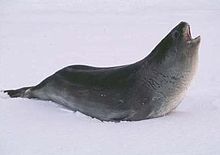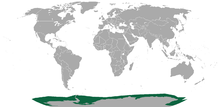Ross seal
| Ross seal | |
|---|---|
 |
|
| Ross seal (Ommatophoca rossii) | |
| Scientific classification | |
| Kingdom: | Animalia |
| Phylum: | Chordata |
| Class: | Mammalia |
| Order: | Carnivora |
| Superfamily: | Pinnipedia |
| Family: | Phocidae |
| Subfamily: | Monachinae |
| Tribe: | Lobodontini |
| Genus: |
Ommatophoca Gray, 1844 |
| Species: | O. rossii |
| Binomial name | |
|
Ommatophoca rossii (Gray, 1844) |
|
 |
|
| Ross seal range | |
The Ross seal (Ommatophoca rossii) is a true seal (family Phocidae) with a range confined entirely to the pack ice of Antarctica. It is the only species of the genus Ommatophoca. First described during the Ross expedition in 1841, it is the smallest, least abundant and least well known of the Antarctic pinnipeds. Its distinctive features include disproportionately large eyes, whence its scientific name (Ommato- meaning "eye", and phoca meaning "seal"), and complex, trilling and siren-like vocalizations.
The Ross seal shares a recent common ancestor with the other Antarctic seals, which are together known as the lobodontine seals. These include the crabeater seal (Lobodon carcinophaga), leopard seal (Hydrurga leptonyx) and Weddell seal (Leptonychotes weddelli). These species, collectively belonging to the seal tribe Lobodontini, share teeth adaptations, including lobes and cusps useful for straining smaller prey items out of the water column. The ancestral Lobodontini likely diverged from its sister clade, Mirounga (elephant seals) in the late Miocene to early Pliocene, when they migrated southward and diversified rapidly in relative isolation around Antarctica. However, the only fossil Ross seals so far known date from much later, during the early of New Zealand.
Ross seals reach a length of about 1.68–2.09 m (5.5–6.9 ft) and weight of 129–216 kg (284–476 lb); females are slightly larger at 1.96–2.5 m (6.4–8.2 ft). A molecular genetic based technique has been established to confirm the sex of individuals in the laboratory. Pups are about 1 m and 16 kg at birth. The coat is colored dark-brown in the dorsal area and silvery-white beneath. At the onset of the Antarctic winter, the coat fades gradually to become light brown. At close range, the Ross seal can be easily identified by its large eyes, which are up to 7 cm in diameter.
...
Wikipedia

